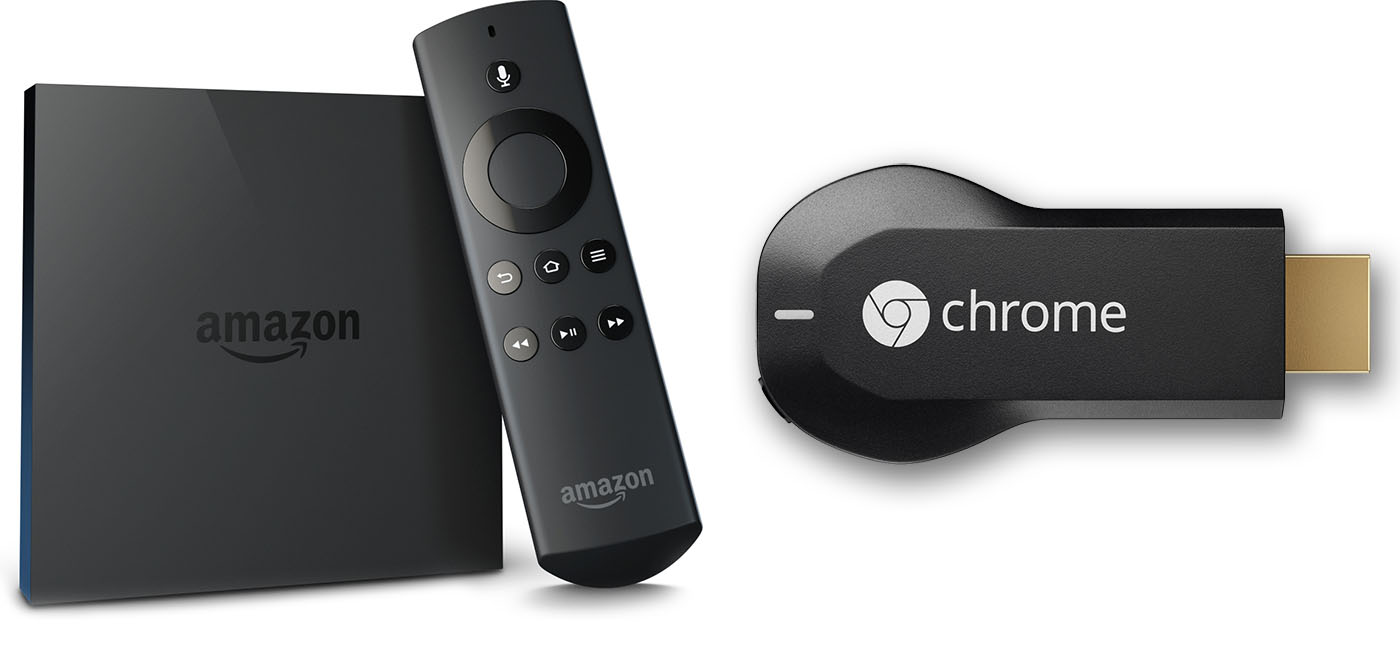Affiliate links on Android Authority may earn us a commission. Learn more.
Amazon Fire TV vs. Chromecast: what's the better deal?

With the announcement of the Fire TV, Amazon has inserted itself into the already pretty crowded media streaming device market, challenging Google, Apple, Roku, and the myriad other me-too devices. But how does it compare to what’s already available?
While there are other big players in the market, if you’re here you probably have a proclivity towards Google devices. With that in mind, lets see how Amazon’s $99 media streamer compares to the $35 Google Chromecast.
Media Services
The key to both devices is the selection of media sources available on them. Both the Chromecast and Fire TV offer access to the most popular streaming services. Netflix and Hulu Plus are present and accounted for on both. As are YouTube, Pandora, Crackle, and Vevo.
When it comes to third-party services Google can boast that the Chromecast has access to HBO Go, which the Fire TV doesn’t have. Amazon comes back with WatchESPN, Showtime Anytime, and Bloomberg TV, which aren’t on the Chomecast.
Of course, each device has access to their respective maker’s media store. The Chromecast offers access to the Play Store, while the Fire TV accesses Amazon Instant Video, including Amazon Prime Instant Video. The big difference between these two is more of a question of ecosystem, which we’ll get into below.
Ecosystem
Both Google and Amazon use their media streaming devices as a sort of extension of their ecosystems, however large or small.
For Google, the Chromecast is a relatively small extension of the Android and Play ecosystem. It lets you access the music and movies you buy from the Play Store, and can stream from Android apps, but that’s about it. The upside to this ecosystem is that Google really doesn’t care what device you have. You can use any Android smartphone or tablet to control the Chromecast with no problems. It even works with iOS apps.
Amazon, on the other hand, mostly seems to play well with its own devices. The second-screen features of the Fire TV are only available on the Kindle Fire HDX, for example. Movies you buy to watch on the Fire TV won’t work on any Android device aside from the Kindle Fire tablets (though they will work on the iPhone and iPad).
Unique Features
| Google Chromecast | Amazon Kindle Fire TV | |
|---|---|---|
Price | Google Chromecast $35 | Amazon Kindle Fire TV $99 |
Form Factor | Google Chromecast Dongle | Amazon Kindle Fire TV Box |
Voice Commands | Google Chromecast No | Amazon Kindle Fire TV Yes |
Processor | Google Chromecast Single core | Amazon Kindle Fire TV Quad core |
Memory | Google Chromecast 512MB | Amazon Kindle Fire TV 2GB |
Controls | Google Chromecast By app via mobile device | Amazon Kindle Fire TV Gaming control, remote |
Gaming Apps | Google Chromecast None | Amazon Kindle Fire TV 100+; "thousands" more coming |
Music Apps | Google Chromecast Google Play, Vevo, Pandora, Rdio, Songza | Amazon Kindle Fire TV Vevo, Pandora, Vimeo |
Sports Apps | Google Chromecast None | Amazon Kindle Fire TV Watch ESPN, NBA League Pass |
Video Apps | Google Chromecast Google Play, HBO Go, Netflix, Hulu Plus, Crackle, YouTube | Amazon Kindle Fire TV Amazon Instant Video, Netflix, Hulu Plus, YouTube, Crackle, Showtime Anywhere, Bloomberg TV |
Remote | Google Chromecast By app via mobile device | Amazon Kindle Fire TV Voice search, physical remote (no line of sight needed) |
Display mirroring | Google Chromecast Yes | Amazon Kindle Fire TV Only via Kindle tablets |
The unique features of the Fire TV are what set it apart from other media streamers, and what makes it so much more expensive than the Chromecast.
At $35, the low price is almost the only selling point you need for the Chromecast. The only special feature it has that others don’t have is the ability to stream Chrome tabs from your desktop to your TV. As more developers build Chromecast support into their apps the device will have more features the others don’t, but for now the Chromecast is pretty bare-bones. Not that there’s anything wrong with just serving your purpose without a bunch of added stuff.
For the Fire TV Amazon has two big features it boasts over other media streamers. The first is voice control. Simply press a button on the remote, say what you’re looking for, and it’ll find that movie or TV show across all available services. The second is gaming. Like the Ouya, the Fire TV promises to bring mobile games to your TV, though controllers cost an additional $39.99, and 2GB really isn’t much space to download many games. Amazon does have some popular games like Asphalt 8 and Badlands on the platform, but aside from the Amazon Game Studios game Sev One, most of the games on the platform you’ve probably already played before.
Is it that simple?
Ultimately, the question of which device is a better deal comes down to your personal preference. Do you want a simple device you control through your phone that does a few things and does them well? You want a Chromecast. Or do you prefer a standalone box with a unified interface and the ability to play a few games? You’ll probably prefer the Fire TV.
For my money, personally, I prefer the Chromecast because I only need my media streaming device to stream media. For those other extra features, including access to Amazon Prime Video, I already have a few game consoles connected to my TV.
Which device do you prefer? How should Google respond?